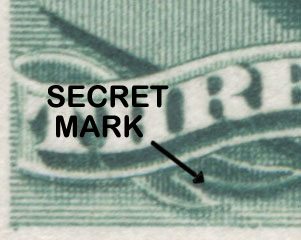
Three-Cent Washington Bank Notes
The Secret Mark and the Reengraved Design

Scott 147P3 - National Printing
Original Design - Proof on India

Scott 158P4 - Continental Printing
Original Design - Proof on Card

Scott 207P4 - American Printing
Reengraved Design - Proof on Card
Closeup of the Secret Mark

Scott 136 and Scott 147 - No secret mark
There is only light shading below the upper ribbon under "THREE"

Scott 158, Scott 184 and Scott 207 - With Secret Mark
There is added shading below the upper ribbon under "THREE".
Closeup of the Reengraved Identifying Area

Scott 136, 147, 158 and 184 - Original Die
There is thick shading around the vignette and no single
strong line of shading underneath the "T" and "S" of "CENTS"

Scott 207 - Rengraved Design
There is only thin shading around the vignette and a single
strong line of shading underneath the "T" and "S" of "CENTS"
Follow these steps in the identification of your three cent Bank Note:
Determine the type of paper the stamp was printed on. If it was printed on "hard white" paper it is either a National or Continental printing. If it was printed on "soft porous" paper, it is an American printing, either Scott 184 or Scott 207. See the diagram above to distinguish the original die and reengraved American printings once the stamp has been determined to be on soft paper.
If it is on hard paper, i.e. either a National or Continental Bank Note printing, check for the "secret" mark. If it has the secret mark it is the Continental Bank Note stamp, Scott 158. If the stamp was printed on hard white paper and does not have the secret mark, it was printed by the National Bank Note Company. If the stamp has a grill, it may be Scott 136. If it does not have a grill it is Scott 147. Care must be taken when authenticating the grill. Many fake grills have been added over the years in an attempt to increase the value of the stamp. A used Scott 136 is common enough that it may not be necessary to certify all copies, but nicely centered, fault-free and particularly, unused stamps should be certified.
If it is an American Bank Note printed on soft porous paper, compare the line of shading around the vignette with the illustrations at top to determine whether it is Scott 184 or Scott 207. Check for the strong added line of shading added underneath the "T" and "S" of "CENTS". If it has the strong line under T and S and lighter shading around the vignette, it is Scott 207. Another difference is the shading under the scroll ball beneath the "U" of "U.S.". On the reengraved stamp the shading is much lighter.
Watch also for removal of the secret mark by scraping, for re-perforation (to fake a more well-centered stamp), for re-gumming (a major problem with the Bank Notes), and even for bleaching of the cancellation (to remove the cancel).
The Special Printings, Scott 167 and Scott 192, are mentioned here merely for completeness. Only 267 copies, total, of Scott 169 and Scott 194 were sold, and they were never issued for postal use, rather for collectors only. We occasionally see uncertified copies of these stamps offered for sale at ridiculously low prices. You can rest assured that the stamp being offered is not genuine. These stamps are so rare, only 60 copies are known, they seldom come up for sale except in the sale of a major U.S. Collection.





